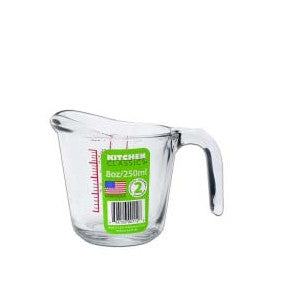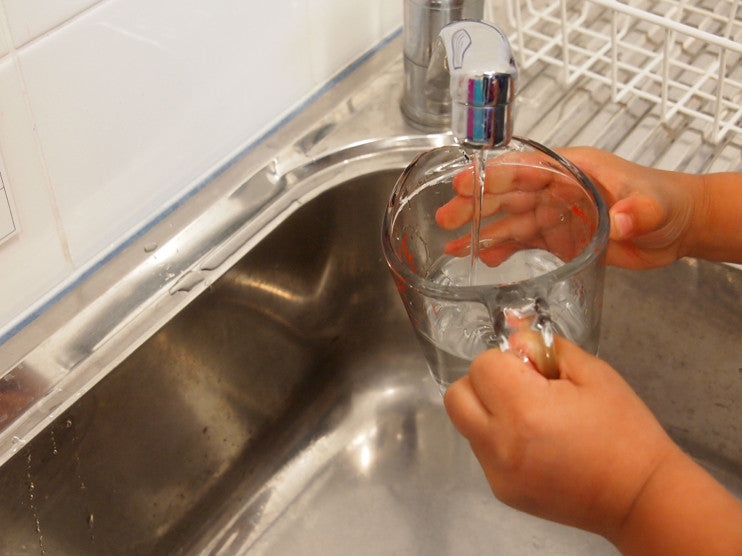Small Glass Measuring Jug (250ml)
A beautiful and functional miniature Measuring Jug. A child will feel empowered and included in the cooking process when using this jug as the aesthetics perfectly reflect the measuring jugs used by adults (in fact, this jug functions perfectly well as a standard adult measuring jug!).
The Glass Measuring Jug is a dual purpose tool - providing a 'pouring' jug (for fine/gross-motor pouring exercises) and also a measuring jug for cooking. It holds a total volume of 250ml (one cup) with clear markings to help a child measure various volumes along the way!


In the hands of a 4 year old.
This is a medium sized jug and can be used for transferring exercises that aim to improve strength and gross motor control. When full it can be a little 'heavy' but still very manageable for a 3 or 4 year old. For that age group it is therefore appropriate as an extension exercise for children who have already mastered pouring with smaller jugs and wish to add the challenging element of weight and attention to accurate measurements. These activities help to promote hand-eye coordination, self-control, concentration and gross motor strength and dexterity.
As with any pouring or cooking activity please remember that spills are an integral part of the learning process, and they also provide a great opportunity to practise the skill of sponging! This is particularly true of pre-school children but older children (and even adults!) spill from time to time during cooking so don't be alarmed by the drips!
The Glass Measuring Jug will have a long lifespan in the home as it is also a useful size for older children. Pre-school and Primary school children alike can engage comfortably with this tool for cooking.
When presenting the act of 'pouring' please remember to identify the following 'points of interest' to the child;
- Both hands should be involved in pouring to create a bi-lateral experience.
- The dominant hand should hold the handle.
- The non-dominant hand should rest under the base when carrying (or on the opposite side of the handle if the child is confident and/or the jug is empty/light).
- The non-dominant hand should rest just under the lip of the jug when pouring.
- The lip of the jug should be lined up with the opening of the receiving vessel (take care to make this clear to the child, as he/she may not be consciously aware of the purpose of the lip).
- The jug should be tipped slowly.
- If you are aware of the child's dominant hand you should try to present your demonstration with this configuration (ie. if the child is left-handed you should try using your left-hand to hold the handle). Whichever hand you use during your presentation the child should be sitting on the opposite side of you (that is, if you are using your right-hand to hold the handle then the child should sit to your left and vice versa). This helps to avoid obstructing the child's view during the presentation.
Please do not be concerned if you have not yet identified the child's dominant / non-dominant hands. Simply present the pouring exercise using the arrangement that is comfortable to you and then engage in observation. The child may mimic you and find this comfortable, or he/she may swap hands immediately (or part-way through) which will give you a clue about their blossoming hand-dominance!
Please be aware that the jug is glass. One of the principles of the Montessori method is that the children are exposed to beautiful, quality, breakable materials. In our modern world many children interact primarily with plastic - and so it is no wonder that they start to believe that they can be rough or irresponsible without consequence! When a child handles a breakable material (such as this jug) he or she is able to feel a sense of responsibility for this fragile, beautiful object. If small chips occur you can point this out to the child to help reinforce the importance of self-control and care. If cracks or breakages occur then it is time to discard the object - and you can invite the child to be part of this process (for instance by observing you wrapping it in newspaper before placing it in the bin) to demonstrate the real, natural consequence of misuse. Please remember that it is not appropriate to shame or scold a child for a breakage - it is an expected part of the learning process. Instead please just be calm and factual about assessing the situation (ie. "The jug is now broken, so it's no longer safe to use, we will need to wrap it up so we can safely throw away the pieces") so the child can self-correct.
For more information about how to supervise and scaffold experiences to protect the safety of the child please read our Safety Advice.


